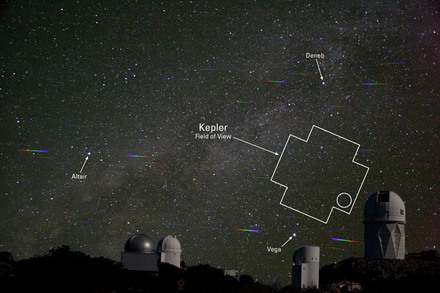Original URL: https://www.theregister.com/2011/12/01/kepler_new_fast_exoplanet/
Kepler spots Earth-sized exoplanet ideal for barbecues
Scorching hot world's year is less than three days, too
Posted in Science, 1st December 2011 11:43 GMT
The Kepler mission has turned up yet another catch for the exoplanet zoo: a planet with an orbit a little over one-tenth that of our Mercury, that zips around its star in 2.8 Earth days.
With that proximity, Kepler-21b isn’t much of a candidate for “habitable zone” nominations: outdoor cooking would be the order of the day. Circling the brightest star in the Kepler star field, the nearly Earth-sized planet probably has a surface temperature of 1,900 K (roughly 3,000°F, or about 1,620°C).

The Kepler star field as seen from the Kitt Peak Observatory.
Kepler-21b is circled. Source: AMES Research Centre.
Kepler-21b circles the 1.3-solar-mass star designated HD 179070 (all the good names were taken), nearly twice the radius of our sun, and probably only 2.84 billion years old. Invisible to the naked eye, the star is quite close – only 352 light-years distant.
The collaboration that turned up Kepler-21b combined ground-based and space observations, and worked for 15 months to distinguish the oscillations caused by the orbiting planet from the star’s own brightness oscillations.
There is, however, one key difference between stellar oscillations and those caused by a planet transiting the star: if the planet has an atmosphere, even a small one, the absorption of light will change the spectrum because of the elements present in the atmosphere.
A team of 66 scientists led by Steve Howell, deputy project scientist at NASA’s AMES Research Center, managed to spot the planet by combining Kepler observations with shots from the Mayall 4-meter telescope and the WIYN telescope at Kitt Peak National Observatory.
The AMES Research Centre announcement is here. ®